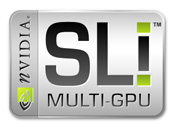The three
different versions of the nForce 4 chipset share all the above features, but
there are still some considerable differences. Let’s look into them,
starting with the low-end nForce 4 socket 754 chipset.
The nForce 4 chipset (Socket 754)
This
variant seems set to be the ‘budget’ nForce 4 release, given that it will be
Socket 754 only, with support for Athlon 64 and Sempron chips. Aside from
the socket, the two main differences between the basic nForce 4 and its
higher-end siblings are in the Hypertransport link between the processor and the
chipset and in the Serial ATA controllers.
The basic
nForce 4 uses an 800 MHz Hypertransport link, as opposed to the 1000MHz
connections found on the nForce 4 Ultra and SLI. This might translate to
slightly reduced performance in demanding graphical applications, since less
bandwidth will be available. The Hypertransport bus will be locked in the
nForce 4, preventing users from raising its speed to increase system
performance.
The basic nForce 4 also
uses standard Serial ATA 150 controllers instead of the brand-new Serial ATA 2
controllers found on the higher-end nForce 4 chipsets.
The nVidia firewall will be present, but not the updated
‘ActiveArmour’ version with hardware support that is seen in the nForce 4 Ultra
and SLI. The processing load will be applied to the CPU not the chipset,
imposing a performance overhead.
The nForce 4 Ultra
The nForce 4 Ultra chipset will probably become the
favourite among the three existing variants, and it’s certainly the one that
manufacturers have jumped on first. It has a full 1000MHz Hypertransport link incorporated, as well as the
new Serial ATA 2 technology, allowing a full 300MB/s of peak data
transfer with compatible hard drives.
The Ultra features nVidia’s new ‘ActiveArmour’ hardware
firewall technology. This offloads firewall operations onto the network
controller built into the chipset, freeing the CPU from the processing load
imposed by firewall operations. If it works as advertised, this
should be a great benefit to gamers, allowing them to protect their systems
while still squeezing out maximum performance. In addition, the firewall
now supports the ‘Intelligent Application Manager’ feature, which monitors and
controls applications in a similar manner to popular software firewalls like
Zonealarm.
The nForce 4 SLI
 The nForce 4 SLI (Scaleable Link
Interface) is slated to be the high-end ‘gamer’s’ chipset of the family. Its
features are identical to those of the nForce 4 Ultra with one huge exception;
it has two PCI Express x16 slots, sharing 16 Hypertransport lanes between
them.
The nForce 4 SLI (Scaleable Link
Interface) is slated to be the high-end ‘gamer’s’ chipset of the family. Its
features are identical to those of the nForce 4 Ultra with one huge exception;
it has two PCI Express x16 slots, sharing 16 Hypertransport lanes between
them.
The chipset is designed to use a pair of SLI compatible
nVidia video cards, and employs a switch built into the chipset to split the 16
PCI Express lanes that would normally feed a single PCI Express video slot into
two sets of eight.
When equipped with two nVidia SLI compatible cards, this
chipset will enable the cards to work in tandem, splitting the rendering of
frames between themselves. What effect this will have on performance is
not clear, but early benchmarks on the web have shown up to an 85% frame rate
increase in some situations. Currently the nVidia 6600GT, 6800GT and 6800
Ultra are the only video cards compatible with nVidia’s SLI mode.
While this setup does mean that each video card only has
half the normal bandwidth of an x16 PCI Express slot available to it, the
benefits of SLI operation should significantly outweigh this fact. This is
especially true considering that modern video cards do not come close to taking
full advantage of the bandwidth that a full PCI Express slot can offer.
The nForce 4 SLI chipset can also be used normally with a
single PCI-Express card in one of the slots, as the switch allows all 16
PCI-Express lanes to be applied to a single slot. The single card does not
have to be SLI compatible.
